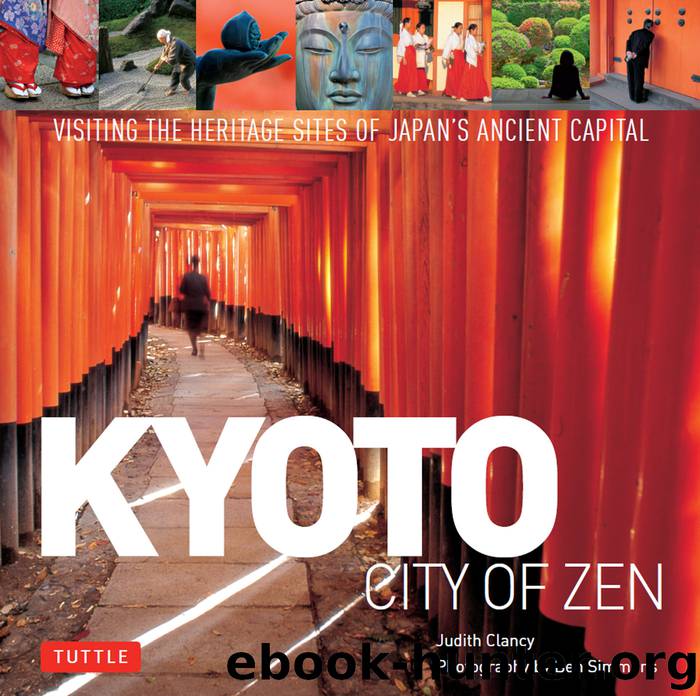Kyoto by Judith Clancy

Author:Judith Clancy
Language: eng
Format: epub
ISBN: 978-1-4629-1023-6
Publisher: Tuttle Publishing
The heavily wooded approach to Shimogamo Shrine.
Two sharp claps to catch the gods’ ears, a whispered prayer and a bow of thanks.
Maple leaves entangled in slender shaga lily leaves.
A visitor entering Shimogamo.
A shrine priest approaches the arched cinnabar-colored bridge at Shimogamo.
DAITOKU-JI TEMPLE COMPLEX
A signboard, now gone, in this complex noted the five desires of mankind that monks in Zen training vow to suppress: wealth, sex, food, pride and sleep. Several times a year, the thwack of a flat wooden stick will resound through the grounds. Sleep and distraction are so tempting during an all-night meditation session that acolytes bow and request the attending monk to administer this sharp stimulus to enhance focus.
Zen temples house Kyoto’s great repositories of 16th century art forms, including exquisite tearooms with their gardens, utensils, fine calligraphy and brush-and-ink paintings. Set in a residential area, the Daitoku-ji Temple complex is open to the public, but the subtemples, which contain some of Kyoto’s finest kare-sansui Zen gardens, require an entrance fee.
Daitoku-ji is a Rinzai sect Zen temple that was established in 1319, and was gradually enlarged under the largess of the wealthy patrons from Sakai City and the famous abbot Ikkyu (1394–1481). Sakai City, in southern Osaka, had many tea enthusiasts, one of whom, Sen-no-Rikyu, later became a leading proponent of this art while living in Kyoto.
When tea first came into wide use, it was imbibed for its medicinal value. As a stimulant, it allowed monks to stay awake during long meditation sessions. Eventually, thanks to the genius of its early practitioners and enthusiasts, the act of making and receiving a cup of tea was codified into a ceremony, further evolving into a spiritual discipline as well as a sophisticated form of entertainment.
Daitoku-ji’s main buildings, as with most Zen temples, are constructed on a north–south axis, with all halls facing south. The first major building in this grid is a large cypress-covered gate, the “Imperial Messenger’s Gate,” and directly north of it is the vermilion Sammon Gate, with a history that brings into focus two of Japan’s most famous men: the warlord Toyotomi Hideyoshi (1537–98) and Sen-no-Rikyu (1511–91), the well-respected tea master from Sakai and a leading connoisseur of the arts connected to tea. Theirs was an entangled relationship of mutual admiration and jealousy. After a strain in their relations, Rikyu ordered an image of himself put on the second floor of the gate, knowing that Hideyoshi would pass beneath his image. Hideyoshi did, and upon learning what Rikyu had done, ordered Rikyu to kill himself, bringing an end to the life of one of Japan’s great arbiters in the fine arts, and imbuing the gate with a reminder of the whims of a powerful ruler and a man who challenged him.
Download
This site does not store any files on its server. We only index and link to content provided by other sites. Please contact the content providers to delete copyright contents if any and email us, we'll remove relevant links or contents immediately.
China Rich Girlfriend by Kwan Kevin(4289)
The Silk Roads by Peter Frankopan(4272)
Annapurna by Maurice Herzog(3296)
Full Circle by Michael Palin(3268)
Hot Thai Kitchen by Pailin Chongchitnant(3210)
Okonomiyaki: Japanese Comfort Food by Saito Yoshio(2625)
The Ogre by Doug Scott(2501)
City of Djinns: a year in Delhi by William Dalrymple(2435)
Photographic Guide to the Birds of Indonesia by Strange Morten;(2407)
Vietnam, Cambodia, Laos & Northern Thailand by Lonely Planet(2315)
Tokyo by Rob Goss(2289)
Tokyo Geek's Guide: Manga, Anime, Gaming, Cosplay, Toys, Idols & More - The Ultimate Guide to Japan's Otaku Culture by Simone Gianni(2239)
Everest the Cruel Way by Joe Tasker(2132)
Discover China Travel Guide by Lonely Planet(2114)
Iranian Rappers And Persian Porn by Maslin Jamie(2095)
China (Lonely Planet, 11th Edition)(2034)
Lonely Planet China(2026)
China Travel Guide by Lonely Planet(1991)
Top 10 Dubai and Abu Dhabi by DK Travel(1987)
